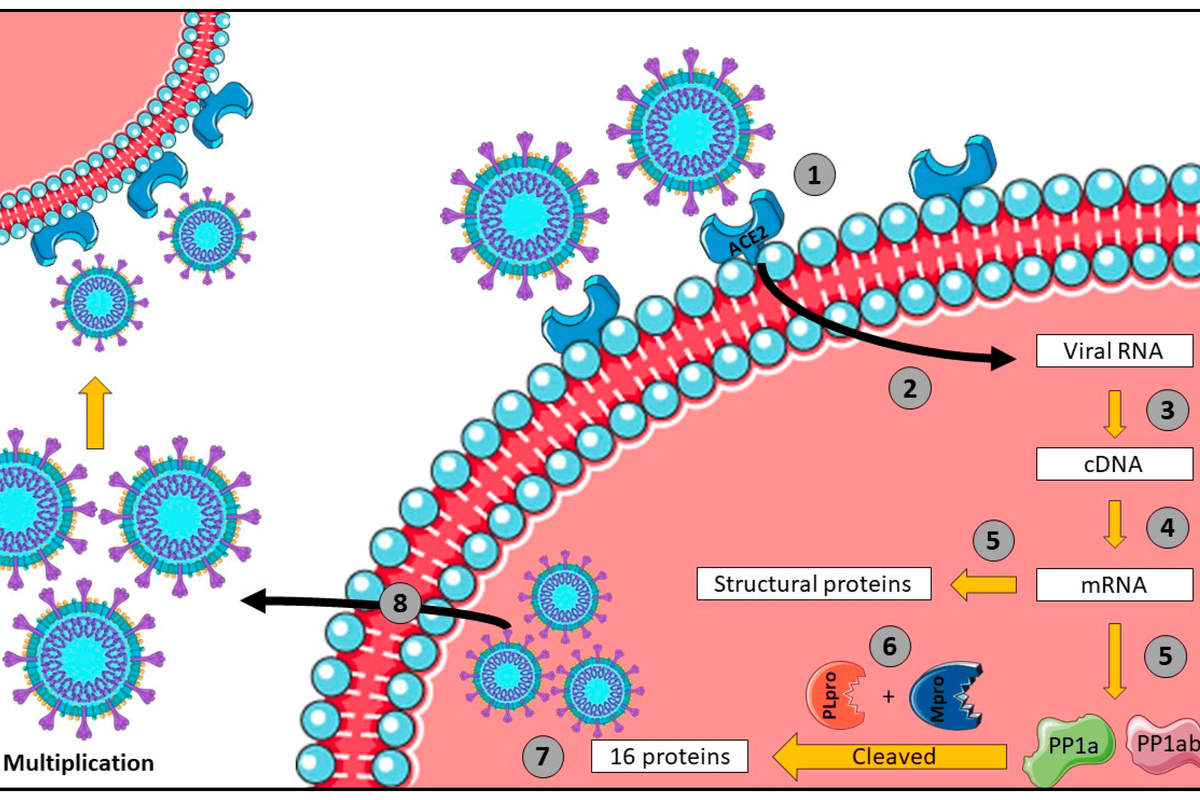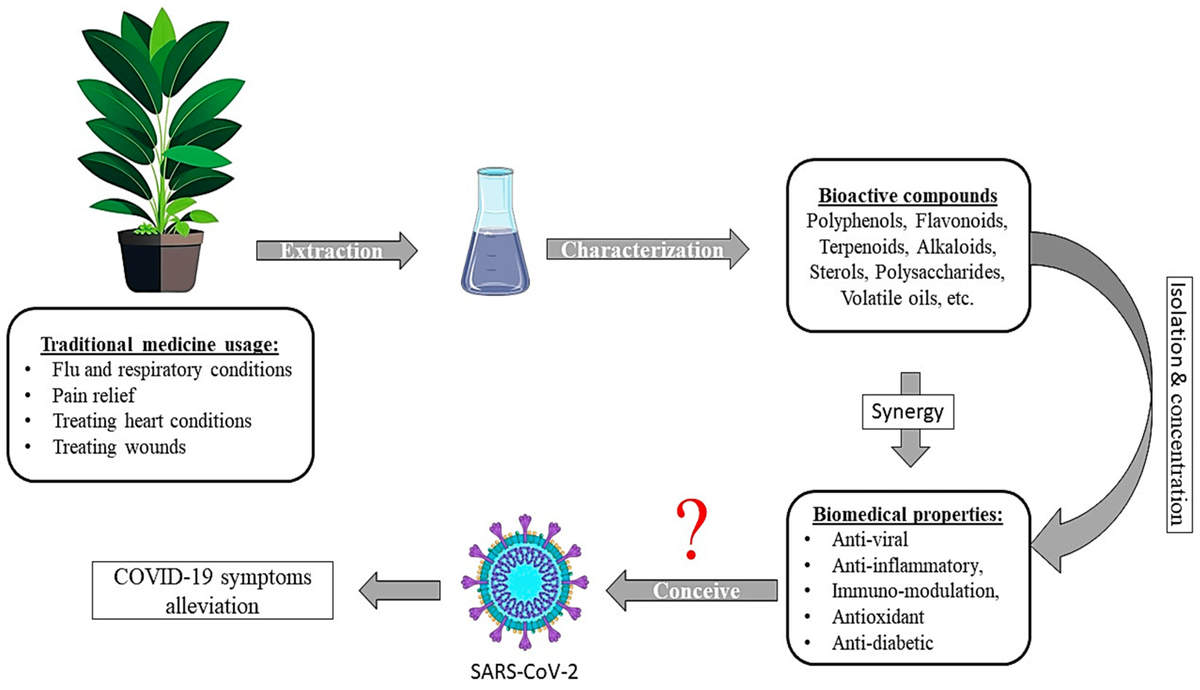
According to a study published in the journal Viruses, ten medicinal plants have been shown to effectively combat SARS-CoV-2.
Our ancestors used various plants for medicinal applications to combat pathogens and infectious diseases. Molecules of plant origin can attack viruses by acting on different aspects of their infection process. A scientific study published in Viruses, a publisher of open-access scientific journals, provides scientific evidence to elucidate the effect of 10 different plants against SARS-CoV-2, paving the way for further studies to re-examine plant-derived extracts, rich in bioactive compounds, in more advanced clinical evaluations to identify their impact on patients suffering from COVID-19.
25 extracts from 8 different plants
Researchers know that herbs and natural compounds can inhibit coronavirus/host protein pathways. In fact, 45 plants have been shown to possess potent antiviral activity against influenza and dermatology-related viruses (e.g. chickenpox, monkeypox and herpes simplex viruses). Similarly, after screening 25 extracts from 8 different plants, Ancistrocladus heyneanus, Bacopa monnieri, Plumeria alba and Cucurbita maxima showed antiviral activity against chikungunya and dengue viruses. More specifically, natural bioactive compounds such as terpenoids, flavonoids, phenols, alkaloids, etc., have proven their high antiviral potential against SARS-CoV-2 particles.

Inflammatory disorders
SARS-CoV-2 infection is associated with inflammatory disorders and, in extreme cases, the development of oxidative stress. As a result, the anti-inflammatory properties of natural plants can alleviate these complications.
Flavonoids (e.g. quercetin, catechins and their derivatives) are known for their antioxidant and antiviral activity. Most of these molecules are effective against enveloped viruses, and can inhibit SARS-CoV-2. In addition, medicinal herbs are widely used to boost immunity against Covid-19, particularly at an early stage of the disease, due to the presence of bioactive molecules, including essential vitamins and minerals.
Preventing virus entry into the host cell
- Ginkgo Biloba is a medicinal plant widely known for its phytotherapeutic and pharmacological properties. In fact, G. biloba extracts (GBE) govern various bioactive components collected from its dried green leaves. More specifically, extracts include flavonoids (quercetin, kaempferol and isorhamnein), biflavones (sciadosity and ginkgetin), trilactone terpenes (ginkgolides and bilobalide) and alkylphenols (gingulo-(GA) acids). These molecules are responsible for the plant’s anti-inflammatory, antioxidant and antiviral properties.
- Turmeric longa. This plant belongs to the Zingiberaceae family and has a variety of uses, such as textile dyes, herbal medicine and food products. Curcumin has anti-inflammatory, antioxidant, antibacterial, antiviral, antifungal, antithrombotic and antiproliferative properties.
- Artemisia annua is an annual herbaceous plant used as a food spice, herbal tea and medicinal herb. It is described as having antihyperlipidemic, anti-plasma, anti-convulsant, anti-inflammatory, antimicrobial, anticholesterolemic and antiviral properties. Several bioactive components have been identified in A. annua, such as sesquiterpenes like artemisinin, arteannuine B and artemisinic acid. Artemisinins are known for their broad-spectrum antiviral activity. These natural bioactive compounds could prevent SARS-CoV-2 viral entry into the host cell. In addition, quercetin inhibits the reinune-angiotensin system (RAS).
- Nigella sativa has been used historically to treat a variety of ailments, including asthma, colds, headaches, nasal congestion and more. N. sativa is a great source of secondary metabolites that could tackle SARS-CoV-2 infection and reduce its symptomatic complications.
- Zingiber officinale, also known as ginger, is a plant belonging to the Zingiberaceae family that is commonly used as a fresh ingredient in cooking or as an herbal treatment in traditional medicine. Ginger contains a variety of bioactive compounds, of which phenolics and terpenoids are the most interesting ingredients. The terpenoids extracted from ginger contain zingiberene, bisabolene and curcumides, while its phenolic compounds are mainly represented by gingerols, shogaols and gingerol-derived compounds such as zingerone. Ginger has a multitude of properties, including antioxidant, anticancer, anti-inflammatory and antiviral activities, making it a popular ingredient in herbal medicine.
- Allium sativum, also known as garlic, is a well-known plant with long, flat green leaves. Their bulbs are aromatic and often used in cooking all over the world. Garlic has a high anti-inflammatory effect due to the presence of a wide variety of sulfated bioactive molecules. In the context of the fight against Covid-19, the importance of this property lies in the inhibition of the cytokine storm by different mechanisms. Firstly, methanolic extracts of aged black garlic inhibit the production of PGE2 and cyclooxygenase. In 2022, a molecular docking study in silico was carried out to screen different compounds extracted from garlic that could attack the SARS-CoV-2 virus by targeting pro 3CL molecules.
- Cinnamomum verum, also known as cinnamon, is often used as a spice in cooking and other products such as toothpaste. It has also been used in pharmacy and traditional medicine for decades. Like most of the plants mentioned in this review, cinnamon is also rich in bioactive compounds that confer the ability to cure many varieties of disease. Cinnamon has powerful antiviral properties against many different particles. This suggests that these molecules have the potential to prevent the SARS-CoV-2 virus from binding to the cell, thereby reducing its cellular infection. It is also known for its anti-diabetic and anti-atherosclerotic activities.
- Rosmarinus officinale, also known as rosemary, is a plant in the Lamiaceae family. Rosemary extracts are rich in bioactive compounds due to their polyphenols and essential oil content. Several studies have shown that these compounds are good scavengers of free radicals, particularly against lipids and active hydroxyls, leading to their stabilization. Rosemary could be a potential candidate for combating the accumulation of free radicals that occurs in SARS-CoV-2 infection. Molecular docking analysis was carried out to assess the binding affinity of 30 compounds extracted from rosemary to the main protease of SARS-CoV-2 compared with remdesivir and favipiravir as positive controls. The studies suggest the possibility of using rosemary as an inhibitor and antagonist of the SARS-CoV-2 life cycle by disrupting its replication inside the host. Rosemary’s anti-inflammatory and analgesic properties are thought to help reduce Covi-19 symptoms by lowering cytokines and pain sensations.
- Taraxacum officinale, otherwise known as Dandelion, has a multitude of benefits for the human body. Dandelions may have antioxidant, anti-obesity, anti-diabetic, antibacterial and antiviral properties. With regard to SARS-CoV-2 infection, high-molecular-weight compounds extracted with water from dandelions have shown efficacy against D614 spike proteins and its various mutants (D614G, N501Y). For example, it stops the interaction between viral S proteins and ACE2 receptors on human kidney and lung cells, thus inhibiting viral adhesion and internalization, which are essential steps in the viral life cycle.
- Origanum vulgare, also known as oregano, is a common plant belonging to the Lamiaceae family. Given that the effects of plant extracts are broader and involve multiple strategies for combating Covid-19, oregano could hold the key to a potentially powerful means of preventing SARS-CoV-2 infection by disrupting its viral life cycle.
More potent than synthetic drugs
In conclusion, write the study’s signatories, given that these 10 plants contain distinct bioactive compounds with significant properties in vitro and with remarkable benefits for human health, it is possible to prevent SARS-CoV-2 infection and reduce its symptomatic manifestations by consuming one of these 10 plants at the recommended dose. The diversity of bioactive molecules between the different plants exerts various effects through different mechanisms at once, making it more potent than conventional synthetic drugs. Nevertheless, further studies are needed to highlight the clinical efficacy of these extracts and identify their possible side effects on patients, particularly those with comorbidities who are taking several conventional drugs.
Jean-Marc Sabatier: “Some plants of interest”.
“Traditional herbal medicine offers remarkable health benefits, as certain plants are able to prevent microbial infections or limit the progression of disease.
certain plants are capable of preventing microbial infections or limiting the progression of disabling symptoms through different mechanistic pathways, with minimal or no side effects or non-existent,” explains Jean-Marc Sabatier, PhD in cellular microbiology. Some plants of interest against Sars-CoV-2 infection and Covid-19 are detailed below. It would therefore be desirable to study specific bioactive plant extracts with a view to evaluating or demonstrating their impact on people suffering from the various pathologies of Covid-19.
Plants and mushrooms (and their extracts) of interest for relieving or treating Covid-19 pathologies are (non-exhaustive list): Artemisia annua (annual mugwort), Ginkgo biloba (Reynoutria japonica (Japanese knotweed), Nigella sativa (black cumin), Aloe vera (Barbados aloe), Curcuma longa (turmeric), Zingiber officinale (ginger), Allium sativum (garlic), Rheum rhabarbarum (rhubarb), Rhamnus cathartica (buckthorn), Rhamnus frangula (borage), Cassia senna (senna), Glycyrrhiza glabra (licorice), Panax ginseng (ginseng), Labiatae Ravintsara or Cinnamomum camphora (Madagascar camphor), Camellia sinensis (green tea), Schisandra sinensis (Schisandra), Berberis aristata (berberine or barberry), Ganoderma lucidum (reishi), Ashwagandha (Indian ginseng), Cinnamomum verum (Ceylon cinnamon), Rosmarinus officinalis (rosemary), Taraxacum officinale (dandelion), Origanum vulgare (oregano), Urtica dioica (nettle), Olea europaea (olive leaves), and Cannabis sativa (hemp oil or cannabidiol). “